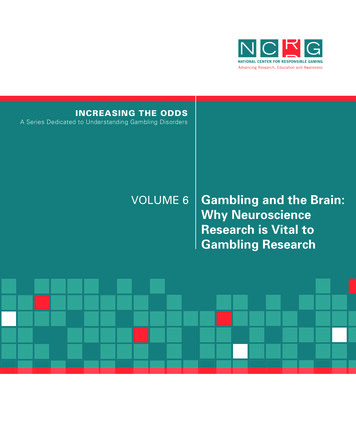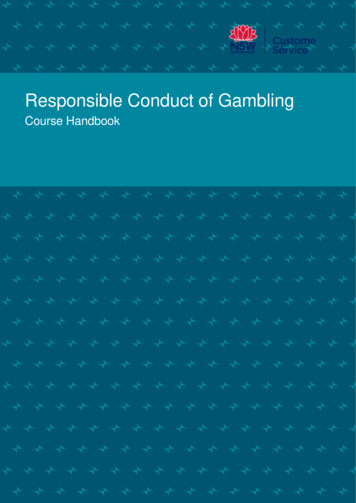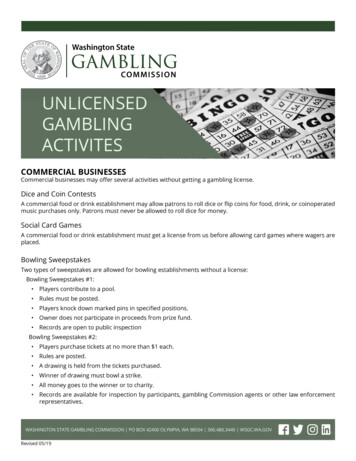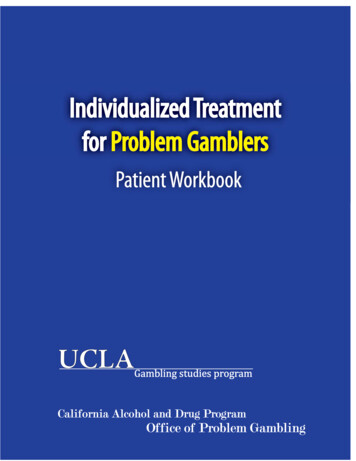
Transcription
INCREASING THE ODDSA Series Dedicated to Understanding Gambling DisordersVOLUME 6Gambling and the Brain:Why NeuroscienceResearch is Vital toGambling Research
2011 National Center for Responsible Gaming. All rights reserved. Parts of this publication may be quotedas long as the author(s) and NCRG are duly recognized. No part of this publication may be reproduced ortransmitted for commercial purposes without prior permission from the NCRG.
TABLE OF CONTENTSINTRODUCTION1Gambling and the Brain: Why Neuroscience Research Mattersby Christine ReillyRESEARCH SUMMARIES3Neurobiology and Pathological Gamblingby Jon E. Grant, M.D., J.D., M.P.H.A summary of Grant, J.E., Brewer, J.A., & Potenza, M.N. (2006). The neurobiologyof substance and behavioral addictions. CNS Spectrums, 11(12), 924-930.9Brain Activity in Pathological Gamblingby Marc Potenza, M.D., Ph.D.A summary of Potenza, M.N., Steinberg, M.A., Skudlarski, P., Fulbright, R.K.,Lacadie, C.M., Wilber, M.K., Rounsaville, B.J., Gore, J.C., & Wexler, B.E. (2003).Gambling urges in pathological gambling: A functional magnetic resonanceimaging study. Archives of General Psychiatry, 60(8), 828-836.14Brain Imaging Studies: A Reviewby Anna E. Goudriaan, Ph.D.A summary of van Holst, R.J., van den Brink, W., Veltman, D.J. & Goudriaan, A.E.(2010). Brain imaging studies in pathological gambling. Current PsychiatryReports, 12(5), 418-425.20The Rat Gambling Task: Understanding the Role of Serotonin and Dopaminein Pathological Gamblingby Catharine A. Winstanley, Ph.D.A summary of Zeeb, F.D., Robbins, T.W. & Winstanley, C.A. (2009). Serotonergicand dopaminergic modulation of gambling behavior as assessed using a novel ratgambling task. Neuropsychopharmacology, 34(1), 1-15.ADDITIONAL INFORMATION25GlossaryA summary of all bolded terms in this publication.27Resources and Programs31About the National Center for Responsible GamingEditor’s note: The summaries and information in this publication were compiled with assistance fromNancy Plemens Mayes, a health and science writer.The first five volumes of Increasing the Odds are available via the NCRG’s Web site, www.ncrg.org.INCREASING THE ODDSVolume 6Gambling and the Brain
INTRODUCTIONGAMBLING AND THE BRAIN: WHY NEUROSCIENCE RESEARCH MATTERSby Christine ReillySenior Research Director, National Center for Responsible Gaming“Addiction is a brain disease — and it matters,” declared Dr. Alan Leshner at the firstNCRG Conference in Gambling and Addiction in 1999. The former head of the NationalInstitute on Drug Abuse explained in an earlier article: “Understanding that addiction is,at its core, a consequence of fundamental changes in brain function means that a majorgoal of treatment must be either to reverse or to compensate for those brain changes”(Leshner, 1997).Although only three years in operation at that point, the National Center for ResponsibleGaming (NCRG) already had heeded this call by supporting several groundbreakingneuroscience projects on gambling disorders. NCRG-funded studies have taken advantageof technological advances in brain imaging, drugs, animal studies and genetics tounderstand the neurobiology of gambling disorders. Since 1996, the NCRG has awardedmore than 2 million for neuroscience research investigations.Although these technological advances are recent, the recognition that gambling disordershave a neurobiological component is not new. Both scientists and clinicians havepreviously observed that people diagnosed with pathological gambling experiencenegative biological consequences (Shaffer & Kidman, 2003). For example, just likeindividuals with drug dependence who develop tolerance for the drug and, therefore, needhigher doses of the drug to experience the desired mood or feeling, those with gamblingproblems might find that they need to gamble increasing amounts of money to achievethe same level of excitement experienced at lower levels of wagering. When such anindividual attempts to reduce or stop gambling, he or she might experience symptoms ofwithdrawal. This process is called neuroadapation and refers to changes in the structureand function of the brain.What is new over the past few decades is the research methodology based on advancesin the field. This volume of Increasing the Odds: A Series Dedicated to UnderstandingGambling Disorders focuses on studies representative of this new wave of neuroscienceresearch. Biochemical, functional neuroimaging, genetic studies and treatment researchhave suggested a strong neurobiological link between behavioral addictions andsubstance use disorders. Given the substantial co-occurrence of these groups ofdisorders, improved understanding of their relationship has importantimplications not only for further understanding the neurobiology of bothcategories of disorders, but also for improving prevention and treatmentstrategies (Grant, Brewer, & Potenza, 2006). Dr. Jon Grant summarizes a reviewarticle in “Neurobiology and Pathological Gambling” that provides a helpfuloverview of this issue, including a discussion of the various neurotransmitters —chemicals that carry signals — implicated in the development of addiction andother psychiatric disorders. Urges to gamble usually precede the self-destructive behaviors observed inindividuals with gambling problems (Potenza et al., 2003). Dr. Marc Potenza’sarticle, “Brain Activity in Pathological Gambling,” illustrates how the brainINCREASING THE ODDSVolume 6Gambling and the Brain1
Gambling and the Brain: Why Neuroscience Research Mattersimaging technology known as fMRI can be used to observe brain function in realtime and, in this case, better understand the role that urges play in thedevelopment and maintenance of a gambling disorder. Dr. Anna Goudriaan provides an abridged version of a review essay, “BrainImaging Studies: A Review,” that gives an overview of brain imaging research ongambling disorders. She shows how various types of imaging are used toinvestigate the role that the reward system, reactivity to cues and impulsivity playin pathological gambling (van Holst et al., 2010). Finally, Dr. Catharine Winstanley summarizes an animal research study in “The RatGambling Task: Understanding the Role of Serotonin and Dopamine inPathological Gambling” that not only demonstrates that laboratory rats can playthe odds, but also provides evidence that the neurotransmitters dopamine andserotonin play a role in gambling behavior (Zeeb, Robbins, Winstanley, 2009).Dr. Leshner’s admonition to pay attention to the neurobiology of addiction was notintended to narrow our understanding of these disorders as purely biological or medical.Addictive disorders, including pathological gambling, have psychological and socialaspects as well. However, the neurobiological research is crucial to understanding thedevelopment of, maintenance of and recovery from addiction. As Dr. Howard J. Shafferobserved, “Ultimately, the brain is the final common pathway for subjective experience;the psychosocial features of experience are painted on the backdrop of neurobiology.We must advance our understanding of this pathway” (Shaffer & Kidman, 2003).REFERENCESGrant, J. E., Brewer, J. A., & Potenza, M. N. (2006). The neurobiology of substance andbehavioral addictions. CNS Spectrums, 11(12), 924-930.Leshner, A. I. (1997). Addiction is a brain disease, and it matters. Science, 278(5335), 45-47.Potenza, M. N., Steinberg, M. A., Skudlarski, P., Fulbright, R. K., Lacadie, C. M., Wilber, M. K.,et al. (2003). Gambling urges in pathological gambling: a functional magneticresonance imaging study. Archives of General Psychiatry, 60(8), 828-836.Shaffer, H. J., & Kidman, R. C. (2003). Shifting perspectives on gambling and addiction.Journal of Gambling Studies, 19(1), 1-6.van Holst, R. J., van den Brink, W., Veltman, D. J., & Goudriaan, A. E. (2010). Brain imagingstudies in pathological gambling. Current Psychiatry Reports, 12(5), 418-425.Zeeb, F. D., Robbins, T. W., & Winstanley, C. A. (2009). Serotonergic and dopaminergicmodulation of gambling behavior as assessed using a novel rat gambling task.Neuropsychopharmacology, 34(10), 2329-2343.About the author Christine Reilly is senior research director of the National Center for Responsible Gaming (NCRG),where she administers the NCRG's research grants program and coordinates educational activitiessuch as the annual NCRG Conference on Gambling and Addiction and EMERGE (Executive,Management, and Employee Responsible Gaming Education). Prior to joining the staff of the NCRGin 1997, Reilly served as executive director of the Missouri Humanities Council for eight years.2INCREASING THE ODDSVolume 6Gambling and the Brain
RESEARCH SUMMARYNeurobiology and Pathological Gamblingby Jon E. Grant, M.D., J.D., M.P.H.University of MinnesotaA summary of the following publication:Grant, J.E., Brewer, J.A., & Potenza, M.N. (2006). The neurobiology of substance andbehavioral addictions. CNS Spectrums, 11(12), 924-930.Over the past decade, the volume and quality ofneurobiological research on behavioral addictions suchas pathological gambling, kleptomania, pyromania,compulsive buying and compulsive sexual behavior hasgrown significantly. However, the vast majority ofresearch in behavioral addictions focuses onpathological gambling. Such behavioral addictions areoften found in conjunction with one or more otherdiseases or disorders, and research has suggestedpossible genetic or neurobiological links betweenbehavioral addictions and substance use disorders.HIGHLIGHTS Imbalances within the neurotransmittersystem of the brain — serotonin, dopamine,endogenous opiods and hormones —influence both behavioral and substanceaddictions. Neuroimaging studies suggest similaritiesbetween behavioral and substanceaddictions. In studies of families with pathologicalgamblers, a possible shared geneticvulnerability between pathologicalgambling and other addictions is evident. Studies of the use of opioid antagonistdrugs and several therapist-driventechniques have proven effective in thetreatment of pathological gambling.This review article congregates information from severalpreviously published research studies about how thenervous system responds in regard to behavioraladdictions and compares those biological responses tothose that are apparent in the study of substance usedisorders. The neurobiology of addictions has beenpredominantly examined in four different realms:1. Biochemical: studies of the chemical processes that occur in living organisms2. Functional neuroimaging: technological techniques that allow brain function to bevisualized3. Genetics: studies of genes, variation and heredity patterns to determine markersthat may indicate elevated addictive vulnerabilities4. Treatment research: research that attempts to measure responses and efficacy ofpsychological and pharmaceutical careBIOCHEMISTRY OF ADDICTIONA complex system of neurotransmitters, such as serotonin, dopamine, endogenousopioids and hormones, are responsible for what we feel, how we think and what we do.Imbalances within this system have been shown to influence both behavioral andsubstance addictions.SerotoninSeveral studies of impulse control disorders have provided evidence of serotonergicdysfunction. Serotonin is implicated in emotion, mood and cognition. As evidenced byINCREASING THE ODDSVolume 6Gambling and the Brain3
Neurobiology and Pathological Gamblingfindings in separate studies, low levels of serotonin, which have been observed inindividuals with pathological gambling habits and substance use disorders, may result inincreased motivation to satisfy urges, impairment in inhibition or reward processing, or acombination of these factors (Potenza, 2001 and Schlosser et al., 1994). Consequently,individuals with serotonergic dysfunction may have difficulty controlling their desires.DopamineIndividuals with impulse control or substance use disorders have shown alterations withinthe dopaminergic pathways, causing them to seek rewards (i.e., gambling or drugs) thattrigger dopamine release and result in feelings of pleasure, which reinforces theproblematic behaviors. One mechanism of addiction, proposed by Kenneth Blum andcolleagues, is “reward deficiency syndrome,” a state of chemical imbalance involvingmultiple genes that causes an individual to crave environmental stimuli to compensate forthe inherent imbalance, regardless of the consequences (Blum et al., 1996).Endogenous OpioidsEndogenous opioids are opiate-like substances, such as endorphins, that function asneurotransmitters. They are produced naturally within the body and contribute to feelingsof well-being and lessen feelings of pain. Dackis and O’Brien’s research (2005) on theneurobiology of addiction demonstrated that individuals with altered opioidergic systemsmight have greater difficulty controlling desires to continue an addictive behavior due tointense euphoric feelings experienced after engaging in rewarding behaviors. Clinicalstudies demonstrating the efficacy in treating impulse control disorders using the opioidantagonists naltrexone and nalmefene, which prevent the body from responding toopiates and endorphins by blocking receptors, have further substantiated involvement ofopioids in both behavioral and substance addictions (Grant & Kim, 2002; Grant et al., 2006;Kim et al., 2001; Mason et al., 1999; and Volpicelli et al., 1992).Stress and Stress HormonesChanges in cortisol have been related to impulse control disorders. Significantly higherlevels of cortisol, a hormone that helps to regulate stress, and adrenaline have beenobserved in individuals after participating in gambling activities (Schmitt et al., 1998).Elevated heart rate levels have also been observed in study participants followingparticipation in gambling activity (Krueger et al., 2005). Such findings support thepossibility of stress pathway involvement in gambling or may indicatethat gambling invokes the stress pathway; however, contradictory neuroimaging studiesfindings necessitate cautious interpretation and further study.of impulse controldisorders suggestsimilarities betweenbehavioral andsubstance addictions.4NEUROIMAGINGExisting evidence from neuroimaging studies of impulse controldisorders suggests similarities between behavioral and substanceaddictions, as indicated by abnormal function (i.e., decreasedactivation) of the ventromedial prefrontal cortex of the brain, which islocated in the frontal lobe and is implicated as a critical component inINCREASING THE ODDSVolume 6Gambling and the Brain
Neurobiology and Pathological Gamblingthe processing of risk and decision making (Potenza, 2006 andPotenza et al., 2004).The mesocorticolimbic dopamine system stimulates theventral striatium, which is strongly associated with emotionaland motivational aspects of behavior. Thus brain imaging datashowing diminished ventral striatial activation observed inindividuals with gambling and drug addictions suggests thatthe mesocorticolimbic dopamine system is involved in bothsubstance and behavioral addictions (Reuter et al., 2005).One brain imaging study measured higher levels of activity inparts of the brain’s limbic system and prefrontal cortex whenmonetary rewards were present versus computer points,suggesting increased sensory and limbic activation withincreased risks and rewards (Hollander et al., 2005). Otherimaging studies have implicated brain regions that areinvolved in attention processing when comparing nonproblem gamblers with pathological gamblers (Crockford etal., 2002).Collectively, these findings suggest a complex network ofbrain regions is activated during gambling and relatedbehaviors, and that activity within certain aspects of theseregions distinguishes pathological gamblers from nonproblem gamblers.GENETIC VULNERABILITYOBSERVED SIMILARITIESBETWEEN BEHAVIORAL ANDSUBSTANCE ADDICTIONS: Repetitive/compulsivebehavior despite adverseconsequences Diminished control over theproblematic behavior A state of anticipatedpleasure prior to engaging inthe problematic behavior A positive, satisfying feelingwhile engaging in theproblematic behavior Tolerance towards theactivity increases over time Occurrence of withdrawalsymptoms Attempts to cut back or stopare often repetitive andunsuccessful High usage rates duringadolescence and youngadulthood Rapid rate of progression toproblematic behavior inwomen compared to menConsistently, family studies have demonstrated thatpathological gambling subjects have elevated rates of firstdegree relatives — parents, children or siblings — withsubstance use disorders, suggesting a possible shared geneticvulnerability between pathological gambling and other addictions (Shah et al., 2004). Studiessuggest that both familial factors and shared genetic vulnerability may account for a portion of therisk for pathological gambling (Comings et al., 1997). However, research has shown that sharedgenetic contributions are not limited to behavior disorders but also include depression (Potenza etal., 2005).Investigations into specific genes relating to neorepinephrine, serotonin and dopamineneurotransmitter systems involved in pathological gambling have been performed and implicatethe specific dopamine-related genes in compulsive/addictive behaviors and disorders, such aspathological gambling, smoking and Tourette’s syndrome (Comings et al., 1997; Comings et al.,1999; Diskin & Hodgins, 2000; and Perez de Castro et al., 1997).INCREASING THE ODDSVolume 6Gambling and the Brain5
Neurobiology and Pathological GamblingDECISION-MAKING ANDNEUROCOGNITIONThe role of frontal cortical regions andthe mesocorticolimbic system inpathological gambling has beensupported by findings in the IowaGambling Task, a tool developed toinvestigate decision-making, particularlythat involving risk-reward assessment,in which subjects with substance usedisorders and behavioral disorderspreferred to choose smaller immediatemonetary rewards over larger delayedrewards (Petry, 2005). This “delayeddiscounting” was exacerbated byconcurrent substance use disorders inindividuals with pathological gambling,strengthening arguments regardingcommonality in brain regions with otheraddictions.Other studies have shown thatindividuals with pathological gamblingmay have a broad range of executivefunctioning deficits, with individualsexhibiting attention deficits and a lowerrate of cognitive control when comparedto healthy subjects (Goudriaan et al.,2005 and Kertzman et al., 2006).However, methodological differencesresulting in discrepant findingsnecessitate additional research.TREATMENTPharmacologicAlthough still in an early stage, several important factorsappear to be emerging in drug treatment of impulse controldisorders. Selective serotonin reuptake inhibitors (SSRIs),most commonly referred to antidepressants, have shownmixed results in impulse control disorders (Grant &Potenza, 2004). Studies using opioid antagonists, such asnaltrexone or nalmefene, have demonstrated efficacy indouble-blind trials for pathological gambling (Grant et al.,2006 and Kim et al., 2001).PsychotherapyIn controlled studies, several therapist-driven techniques,such as cognitive-behavioral therapy, MotivationalInterviewing and relapse prevention, modeled ontreatments for substance use disorders, have demonstratedefficacy (Shah et al., 2004).Self-Help GroupsTwelve-step self-help groups patterned after AlcoholicsAnonymous seem to be the most widely used treatment forimpulse control disorders; however, these groups sufferfrom high dropout rates, and there is little controlledevidence to support their effectiveness.FUTURE IMPLICATIONSPrevention and treatment strategies are expected toimprove as increased understanding of differentneurobiological disturbances that exist in individuals withimpulse control disorders emerges via continued researchand correlation to substance use disorders. Evidence-basedtreatments suggest that specific groups of impulse control disorders respond preferentiallyto specific treatments, thus step-by-step procedures for diagnosing pathological gamblingbased on the presence or absence of co-occurring disorders have been proposed to guideclinical treatments (Hollander et al., 2004). Emerging data suggest that pathologicalgambling co-occurs with disorders more often than not, although further investigation isneeded to better understand the relationship of impulse-control disorders to otherpsychiatric disorders so that more structured, evidence-based screenings and treatmentsmay be created to assist clinicians.6INCREASING THE ODDSVolume 6Gambling and the Brain
Neurobiology and Pathological GamblingREFERENCESBlum, K., Cull, J.G., Braverman, E.R., & Comings, D.E. (1996). Reward deficiencysyndrome. American Scientist, 84, 123-145Comings, D.E., Gade, R., Wu, S, et al. (1997). Studies of the potential role of the dopamineD1 receptor gene in addictive behaviors. Molecular Psychiatry, 2, 44-56.Comings, D.E., Gonzalez, N., Wu, S., et al. (1999). Studies of the 48 bp repeatpolymorphism of the DRD4 gene in impulsive, compulsive, addictive behaviors:Tourette syndrome, ADHD, pathological gambling, and substance abuse. AmericanJournal of Medical Genetics, 88, 358-368.Crockford, D.N., Goodyear, B., Edwards, J., Quickfall, J., & el-Guebaly N. (2002). Cueinduced brain activity in pathological gamblers. Biolgoical Psychiatry, 58, 787-795.Dackis, C. & O’Brien, C. (2005). Neurobiology of addiction: treatment and public policyramifications. Nature Neuroscience, 8, 1431-1436.Diskin, K.M., Hodgins, D.C. (2000).Narrowing of attention and dissociation in pathologicalvideo lottery gamblers. Journal of Gambling Studies, 16, 461-467.Goudriaan, A.E., Oosterlaan, J., de Beurs, E., & van den Brink, W. (2005). Decision makingin pathological gambling: a comparison between pathological gamblers, alcoholdependents, persons with Tourette syndrome, and normal controls. CognitiveBrain Research, 23(1), 137-51.Grant, J.E. & Kim, S.W. (2002). An open label study of naltrexone in the treatment ofkleptomania. Journal of Clinical Psychiatry, 63, 349-356.Grant, J.E. & Potenza, M.N. (2004). Impulse control disorders: clinical characteristics andpharmacological management. Annals of Clinical Psychiatry, 16, 27-34.Grant, J.E., Potenza, M.N., Hollander, E., et al. (2006). A multicenter investigation of theopioid antagonist nalmefene in the treatment of pathological gambling. AmericanJournal of Psychiatry, 163, 303-312.Hollander, E., Kaplan, A., & Pallanti, S. (2004). Pharmacological treatments. In J.E. Grant &M.N. Potenza (Eds.), Pathological gambling: a clinical guide to treatment (pp. 189206). Washington, D.C.: American Psychiatric Publishing, Inc.Hollander, E., Pallanti, S., Baldini Rossi, N., Sood, E., Baker, B.R., & Buchsbaum, M.S.(2005). Imaging monetary reward in pathological gamblers. World Journal ofBiological Psychiatry, 6, 113-120.Kertzman, S., Lowengrub, K., Aizer, A., Ben Nahum, Z., Kotler, M., & Dannon, P.N. (2006).Stroop performance in pathological gamblers. Psychiatry Research, 142, 1-10.Kim, S.W., Grant, J.E., Adson, D., & Shin, Y.C. (2001). Double-blind naltrexone andplacebo comparison study in the treatment of pathological gambling. BiologicalPsychiatry, 49, 914-921.Krueger, T.H.C., Schedlowski, M., & Meyer, G. (2005). Cortisol and heart rate measures duringcasino gambling in relation to impulsivity. Neuropsychobiology, 52, 206-211.Mason, B.J., Salvato, F.R., Williams, L.D., Ritvo, E.C., & Cutler, R.B. (1999). A double-blindplacebo-controlled study of oral nalmefene for alcohol dependence. Archives ofGeneral Psychiatry, 56, 719-724.INCREASING THE ODDSVolume 6Gambling and the Brain7
Neurobiology and Pathological GamblingPerez de Castro, I., Ibanez, A., Torres, P., Saiz-Ruiz, J., & Fernadez-Piqueras, J. (1997).Genetic association study between pathological gambling and a functional DNApolymorphism at the D4 receptor gene. Pharmacogenetics, 7, 345-348.Petry, N.M. (2005). Pathological gambling: etiology, comorbidity, and treatment.Washington, D.C.: American Psychological Association.Potenza, M.N. (2001). The neurobiology of pathological gambling. Seminars in ClinicalNeuropsychiatry, 6, 217-226.Potenza, M.N. (2006). Should addictive disorders include non-substance-relatedconditions? Addiction, 101(1), 142-151.Potenza, M.N., Stienberg, M.A., Skudlarski, P., et al. (2004). Neuroendocrine response tocasino gambling in problem gamblers. Psychoneuroendocrinology, 29, 1272-1280.Potenza, M.N., Xian, H., Shah, K., Scherrer, J.F., & Eisen, S.A. (2005). Shared geneticcontributions to pathological gambling and major depression in men. Archives ofGeneral Psychiatry, 62, 1015-1021.Reuter, J., Raedler, T., Rose, M., Hand, I., Glascher, J., & Buchel. C. (2005). Pathologicalgambling is linked to reduced activation of the mesolimbic reward system. NatureNeuroscience, 8, 147-148.Schlosser, S., Black, D.W., Perertinger, S., & Freet. D. (1994). Compulsive buying:demography, phenomenology, and comorbidity in 46 subjects. General HospitalPsychiatry, 55, 5-11.Schmitt, L.H., Harrison, G.A., & Spargo, R.M. (1998). Variation in epinephrine and cortisolexcretion rates associated with behavior in an Australian Aboriginal community.American Journal of Physical Anthropology, 106, 249-253.Shah, K.R., Potenza, M.N., & Eisen, S.A. (2004). Biological basis for pathologicalgambling. In J.E. Grant & M.N. Potenza (Eds.), Pathological gambling: a clinicalguide to treatment (pp. 127-142). Washington, D.C.: American PsychiatricPublishing, Inc.Volpicelli, J.R., Alterman, A.L., Hayashida, M., & O’Brien, C.P. (1992). Naltrexone in thetreatment of alcohol dependence. Archives of General Psychiatry, 49, 876-880.About the author Jon E. Grant, M.D., J.D., M.P.H., is a professor of psychiatry at the University of Minnesota andco-directs a clinic for Impulse Control Disorders at the University of Minnesota Medical Center inMinneapolis, Minn. Grant completed a law degree from Cornell University, a medical degree fromBrown University, and a master’s degree in public health from Harvard University. He is the authorof Stop Me Because I Can’t Stop Myself, a book on impulse control disorders, and co-editor ofPathological Gambling: A Clinical Guide to Treatment and Textbook of Men’s Mental Health. Hewas honored by the National Center for Responsible Gaming in 2009 with the NCRG ScientificAchievement Award in the Senior Investigator Category. Grant is also the principal investigatorof the NCRG’s Center of Excellence in Gambling Research at the University of Minnesota.8INCREASING THE ODDSVolume 6Gambling and the Brain
RESEARCH SUMMARYBrain Activity in Pathological Gamblingby Marc Potenza, M.D., Ph.D.Yale University School of MedicineA summary of the following publication:Potenza, M.N., Steinberg, M.A., Skudlarski, P., Fulbright, R.K., Lacadie, C.M., Wilber, M.K.,Rounsaville, B.J., Gore, J.C., & Wexler, B.E. (2003). Gambling urges in pathologicalgambling: A functional magnetic resonance imaging study. Archives of GeneralPsychiatry, 60(8), 828-836.INTRODUCTIONPathological gamblers often experience urgesimmediately before engagement in self-destructivegambling behaviors, just as individuals suffering fromsubstance use disorders, obsessive-compulsive disordersand other impulse control disorders typically experienceurges before engaging in associated self-destructivebehaviors.This study analyzed brain function collected viaechoplanar functional magnetic resonance imaging(fMRI), which offers one of the fastest, most efficientmeans of measuring localized changes in brain activity.Participants viewed videotaped scenarios — with contentdepicting scenes of happiness, sadness and gambling.Comparisons were then made based on the participants’ratings of the quality and magnitude of their emotionaland motivational responses.HIGHLIGHTS Functional MRI (fMRI) technologymeasures changes in brain activity andis helping researchers understand moreabout the urges experiencedimmediately before self-destructivegambling behavior. In this study, pathological gamblersshowed less activity in the regions ofthe brain governing emotion regulation,decision-making and impulse controlwhen shown video images of gamblingscenarios. This study provides additional evidencethat pathological gamblers are moreimpulsive and sensation seeking thancomparison subjects.OBJECTIVEOther studies of substance use disorders and obsessive-compulsive disorders haveidentified brain activity related to anticipatory states. By identifying which areas of thebrain are actively associated with gambling urges in pathological gamblers, we may betterunderstand the relationship among pathological gambling, substance use disorders andobsessive-compulsive disorders. Better understanding can help direct research to developeffective treatments for pathological gambling.HYPOTHESESBased on higher rates of co-occurrence and a greater sense of anticipatory excitement forpathological gambling and substance use disorders than for pathological gambling andobsessive-compulsive disorders, it was hypothesized that brain activity associated withgambling urges would be more similar to cocaine cravings in cocaine dependence than toobsessions in obsessive-compulsive disorder. Specifically, it was hypothesized that theINCREASING THE ODDSVolume 6Gambling and the Brain9
Brain Activity in Pathological GamblingThe Limbic System is a set ofbrain structures that governsemotions and behaviors, andalso supports functionsincluding long-term memoryand sense of smell. The limbicsystem is highly interconnectedwith the nucleus accumbens, acollection of neurons that hasbeen proposed to function asthe brain’s “pleasure center”and play an important role inreward, pleasure, addiction,aggression and fear.Cortico-basal-ganglionicthalamic System is a set ofbrain structures consisting ofthe cerebral cortex, basalganglia and thalamus. Eachfunctional region of the frontalcortex is connected withspecific areas of each basalgan
GAMBLING AND THE BRAIN: WHY NEUROSCIENCE RESEARCH MATTERS by Christine Reilly Senior Research Director, National Center for Responsible Gaming “Addiction is a brain disease — and it matters,” declared Dr. Alan Leshner at the first NCRG Conference in Gambli










